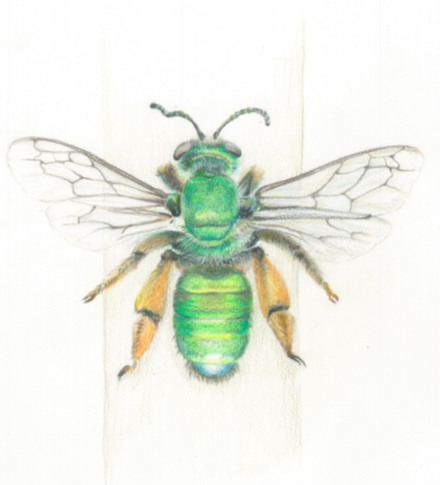Insects Of New Junction
Stage 2 of Weeip Park is now complete, and includes a children’s play area with a nature theme.
The area has a number of larger than lifeover scaled insects sculptures that are common in the area and native to WA.
Insects include the Spoon winged Lacewing, Green burrowing bee, Sluggish snout nosed Katydid, Dawsons burrowing bee, Carthaid moth lava, Jewel Beetle and the Western Jewell butterfly.
In conjunction with Nature Play WA, the City of Swan has created a Play Trail app to explore the habitat play space.
Unlock site specific content, complete challenges, solve quiz questions and score points with the Nature Play WA Play Trails app.
Click here for the link to download the Apple and Android app: Play Trails App - Nature Play WA
Western Petaltail
The Petalura Hesperia is the largest dragonfly found in Western Australia. The larvae, known as nymphs, live in holes dug in swampy ground. They differ from most other nymphs in that they come out of the water, usually at night, to catch prey. The adults emerge in early summer, but are rarely seen.
The species is only known from a few localities near Perth.
Sluggish snout nosed Katydid
All four species of Mygalopsis are restricted to south-western Australia where they inhabit the wetter heathlands. Males ‘sing’ at night, head down, on the lower stems of shrubs. Adults measure about 4 cm in body length and are notable for their relatively short hind legs and very short wings. Females are distinguished by a sword-like ovipositor - a tube-like organ used for the laying of eggs.
Western Jewel Butterfly (Hypochrysops halyaetus)
This little member of the family of ‘blues’ (Lycaenidae) is confined to open heath on coastal sand dunes and banksia woodland areas from Perth to North-West Cape. In the Perth area, adults are in flight from October to December but they emerge as early as July on NW Cape. Wing span is approximately 2.5 cm.
The butterflies are often found in large numbers near the ground, where the males usually perch on twigs or leaves. Compared to other species, the Turquoise Jewel is very easy to approach and observe, even in sunny and warm conditions.
Carthaeid Moth Lava
The dryandra moth is a species of moth that is considered to be the sole member of the family Carthaeidae. A relative of silk moths and emperor moths, this species from south-western Australia is placed in a family of its own (Carthaeidae).
The common name is derived from the Dryandra shrubs of the genus Banksia, on which the larva of this species feed, and is hence restricted to the south-west of Western Australia where these shrubs grow
The adults fly only at night, from October to December. When disturbed, adult moths tend to lower the head and abdomen, bringing the forewings forward to expose the large spots on the hindwings, which oscillate from side to side, giving the aggressor the impression that it is being watched by two large eyes (such as an owl), in an attempt to cause the aggressor to refrain from attacking..
Jewel Beetle
The JEWEL BEETLE (STIGMODERA GRATIOSA) is just one of hundreds of species of jewel beetles occurring in WA.
Bodies and legs of this species were used in pieces of jewellery in earlier times because their iridescent colour never fades.
The species inhabits south-western W.A. from North-West Cape to the southern edge of the Nullarbor Plain. Adults may be found visiting various white flowers during the months of September to December.
They measure 1.5 to 2.0 cm in body length.
Green Burrowing Bee
CTENOCOLLETES SMARAGDINUS is a glorious metallic green species that is much larger than a honeybee. It is one of 12 species of its genus and, like most of them, is confined to W.A. It is found in heathlands of the southern wheatbelt and southern goldfields and flies during the spring flowering season. It nests solitarily and its nest entrances are very inconspicuous.
Spoon Winged Lacewing
Spoonwing lacewings are large to medium-size insects measuring approximately 16 millimeters in length, with a wingspan up to 55 millimeters. The body is long and thick, with relatively broad, rounded forewings.
Their flight is delicate and they have a circling flight to avoid walls when they are trapped indoors.
Chasmoptera, with seven species, is confined to south-western Australia. Other genera of spoon-winged lacewings occur in Africa, southern Europe and South America.
The common name (spoon-wings) alludes to the stalked hindwings which can measure up to 40 mm in length. One species is still found in bushlands around Perth during November and December. Little is known about the behaviour and life-history of these odd insects.
Dawsons Burrowing Bee (Amegilla dawsoni)
Amegilla dawsoni, sometimes called the Dawson's burrowing bee is a species of bee that nests by the thousands in arid claypans in Western Australia. It is a long tongued bee, of the tribe Anthophorini and genus Amegilla, the second largest genus in Anthophorini.
The Dawson's burrowing bee is one of the largest Australian bee species, growing to be 23 millimetres in length and 45 millimetres in wingspan. With the exception of their faces, the bees are covered in brown fur, if male, or brown and white fur if female. They are similar in size and colouring to Australian carpenter bees.








